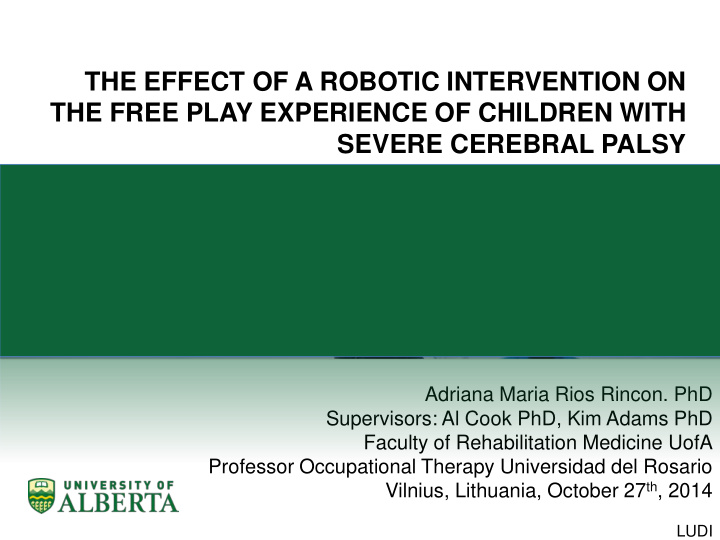



THE EFFECT OF A ROBOTIC INTERVENTION ON THE FREE PLAY EXPERIENCE OF CHILDREN WITH SEVERE CEREBRAL PALSY Adriana Maria Rios Rincon. PhD Supervisors: Al Cook PhD, Kim Adams PhD Faculty of Rehabilitation Medicine UofA Professor Occupational Therapy Universidad del Rosario Vilnius, Lithuania, October 27 th , 2014 LUDI
Introduction - Elements of Playfulness High Playfulness Play Nonplay Low Playfulness Frame Elements of Playfulness. Adapted from: Skard, G., & Bundy, A. (2008). Test of Playfulness. In L. D. Parham, & L. S. Fazio, Play in occupational therapy for children (p. 73). St, Louis: Mosby Elsevier.
Introduction - Elements of Playfulness High Playfulness Play Nonplay Low Playfulness Frame Elements of Playfulness. Adapted from: Skard, G., & Bundy, A. (2008). Test of Playfulness. In L. D. Parham, & L. S. Fazio, Play in occupational therapy for children (p. 73). St, Louis: Mosby Elsevier.
Introduction - CP – Mother-child play interaction • Mothers: more directive and less responsive • Children: more passive, less responsive and more compliant
Objectives • Investigate the effect of a robot-based intervention to promote free play, provided in the child’s natural environments, on • Child’s playfulness • Mother’s directiveness, responsiveness and affect/animation • Child’s play performance and satisfaction with the performance • Identify the mother’s satisfaction with the intervention.
Questions and hypothesis Variable Intervention Follow-up H1: ToP ToP ? Playfulness H2: MBRS-D MBRS-D ? Maternal Directiveness H3: MBRS-R MBRS-R ? Maternal Responsiveness MBRS-AA ? MBRS-AA ? Maternal Affect/Animation COPM-P ? COPM-P ? Occupational play performance COPM-S ? COPM-S ? Satisfaction with the occupational performance ? Satisfaction with the intervention
Methodology Partially non-concurrent multiple baseline design Baseline Intervention Follow-up TRAINING 2.5 - 4 weeks 5 - 6 weeks 4 weeks 10 sessions 3 sessions 5-8 sessions ToP - MBRS – COPM
Methodology - Participants MP01 P01 MP02 P02 • 9 y/ 4 m • 5 y/ 5 m • PTI-2:Very poor • PTI-2: Below average • Very limited spoken GMFCS IV-V • Good level of spoken language MACS IV-V language MP03 MP04 P03 P04 • • 6 y/ 4 m 8 y/ 11 m • • PTI-2: Below average PTI-2: Poor • • Limited spoken Very limited spoken language language
Results – Children’s playfulness IRD=100% IRD=58% 30% 0% IRD=100% IRD=100% 0% 0% IRD=Improvement Rate Difference
Results: Mother’s Directiveness IRD=60% IRD=100% 0% 40% IRD=100% IRD= -40% 0% 90% IRD=Improvement Rate Difference
Results: Mother’s Responsiveness 0% 0% IRD= NA 100% 100%
Results Hypotheses Intervention Supported? Evidence Playfulness H1 : ToP YES Strong evidence H2 : MBRS-D Maternal YES Moderate Directiveness 3 mothers evidence H3 : MBRS-R Maternal NO No Responsiveness 2 mothers evidence No change 2 mothers (ceiling effect?)
Results Questions Intervention Follow-up ToP 3 children Playfulness MBRS-D 2 mothers Maternal Directiveness MBRS-R 1 mother Maternal Responsiveness Maternal Affect/Animation No change No change Occupational play COPM-P COPM-P 100% concerns 36% concerns (2 ch) performance Satisfaction with the COPM-S COPM-S 81% concerns (3 ch) 45% concerns (2 ch) occupational performance 9% concerns (1 ch) Satisfaction with the YES intervention
Discussion – No Robot - I do not know how you want to play - You seem distracted - I need to manipulate your toys I cannot play - This is what your with my toys! therapist said to do Mom, tell me what to do Low Playfulness Mother child Responder Initiator Distracted High Directiveness Dominates Passive Minimal Responsiveness the play Compliant
Video No Robot
Discussion - Robot Go to explore! “what can I do with I am ready to these objects help when using robot?” needed You can play with your toys! Mom I need you I am satisfied I can help me. I want to play with do… my toys! Playfulness Mother Child Sensitive Responder adaptation Initiator Follows the Lead the Directiveness child play play interests
Videos Robot
Discussion – HAAT Model Natural Environment Social Context: Mother Framing Control self Human Child Activity Technology Free play Lego Robot Switches Intrinsic Motivation Internal Control Freedom to suspend Programs reality Robot’s movements Context Physical Context: Toys
Conclusions • Use of the robot have an impact on children’s playfulness and can have an impact on mother’s behavior, perception and satisfaction • AT can impact children’s social context • Carryover of children’s playfulness. Tendency towards the baseline levels
Discussion - Novelty and contributions • First study that investigates the effect of a robotic intervention on free play of children with motor impairment. • The intervention was child-oriented but still had an effect on maternal directiveness and responsiveness for some mothers.
Discussion - Limitations a future research Limitations Future research • Researcher not blinded • Larger sample. Other cultures • Inexpensive technology • Effects on: • MBRS Ceiling effect? • Mastery motivation, sense of competence, and self-efficacy • Small sample of children • Coordination, manipulation, posture, and communication • Different playmates • Pretend play • Use of better robots
Additional Support Acknowledgements Anita Bundy PhD Patty Rigby PhD Advisor Committee Rosario Laserna MSc Supervisor: Al Cook PhD Sharon Warren PhD Juan Forero PhD Co-supervisor: Kim Adams PhD Monica Moreno PhD Claudia Castillo MSc student Joyce Magill-Evans PhD Fernanda Arbelaez FT Antonio Miguel Cruz PhD Examiners Johanna Darrah PhD Veronica Smith PhD Brenda Skrypnek PhD Al Fleming Robert Palisano PhD Giselle Pelaez OT (Colombia) Paola Rocio Esquivel OT student (Colombia) Lina Maria Becerra OT student (Colombia) Participants Asociación ACONINO (Colombia) Centro de Capacitación San Pedro Poveda (Colombia)
Thank you
Recommend
More recommend